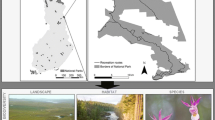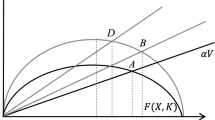Abstract
Attracting visitors to an alpine national park can open up additional sources of funding for species conservation. However, tourism also brings ecologically negative impacts to the park and, in particular, to endangered species. In this paper, we discuss the handling of this two-edged effect of nature-based tourism within the context of a national park’s management decision. We develop a stylized model which frames the interaction of a representative largely unknown species, its habitat, and park visitors in an alpine ecosystem. In applying this to the protection of a rock partridge population in the Hohe Tauern National Park (Austria), we illustrate that a combined visitor and species protection policy can maximize steady state net benefits from tourism and conservation, while ensuring that the endangered species reaches its conservation target in the long run. Thus, even for a small, largely unknown species such as the rock partridge, and not only for popular species like the golden eagle, it is possible to endogenously generate a conservation budget by attracting visitors.
Similar content being viewed by others
References
Alexander RR, Shields S (2003) Using land as a control variable in density-dependent bioeconomic models. Ecol Model 170: 193–201
Ando A, Getzner M (2005) The roles of ownership, ecology, and economics in public wetland-conservation decisions. Ecol Econ 58(2): 287–303
Begon M, Harper JL, Townsend CR (1996) Ecology. Individuals, populations and communities, 3rd edn. Blackwell, Malden
Behrens D, Friedl B, Gebetsroither B, Getzner M, Lieb S (2006) Optimal dynamic nature conservation strategies. Final report to the Jubiläumsfonds der Oesterreichischen Nationalbank (Austrian Central Bank), project No. 11216, Klagenfurt/Graz
BirdLife International (2004) Birds in Europe: population estimates, trends and conservation status, Birdlife Conservation Series, vol 12. Birdlife International, Cambridge
BirdLife International (2008a) BirdLife’s online World Bird Database: the site for bird conservation. Version 2.1. BirdLife International, Cambridge, UK. http://www.birdlife.org. Accessed 22 Jan 2009
BirdLife International (2008b) Species factsheet: Alectoris graeca. http://www.birdlife.org. Accessed 22 Jan 2009
Blanc R, Guillemain M, Mouronval J-B, Desmonts D, Fritz H (2006) Effects of non-consumptive leisure disturbance to wildlife. Rev d’Ecol, La Terre et la Vie 61(2): 117–133
Bulte E, van Kooten GC (1999) Economics of antipoaching enforcement and the ivory trade ban. Am J Agr Econ 81: 453–466
Conrad JM (1999) Resource economics. Cambridge University Press, Cambridge
Damania R, Bulte EH (2007) The economics of wildlife farming and endangered species conservation. Ecol Econ 62: 461–472
Dawson D, Shogren JF (2001) An update on priorities and expenditures under the Endangered Species Act. Land Econ 77(4): 527–532
Eichner T, Tschirhart J (2007) Efficient ecosystem services and naturalness in an ecological/economic model. Environ Resour Econ 37: 733–755
EUROPARC and IUCN (2000) Richtlinien für Managementkategorien von Schutzgebieten—Interpretation und Anwendung der Managementkategorien in Europa. Europarc and WCPA (World Commission on Protected Areas), Gland, Grafenau
Frey H (1999) Estimation of the costs for captive bred Bearded Vultures within the framework of the European Bearded Vulture project. Bearded Vulture. Reintroduction into the Alps. Annual Report 1998, pp 75–77
Friedl B, Behrens DA (2007) Optimal balancing of recreation and wildlife conservation: a case of the Golden Eagle. In: Kontoleon A, Pascual U, Swanson T (eds) Biodiversity economics: principles, methods and applications. Cambridge University Press, Cambridge, pp 531–556
Frühauf J (2005) Rote Liste der Brutvögel (Aves) Österreichs. In: Zulka KP (eds) Rote Liste gefährdeter Tiere Österreichs. Teil 1, Grüne Reihe 14/1, pp 63–165
Getzner M, Jost S, Jungmeier M (2002) Naturschutz und Regionalwirtschaft: Regionalwirtschaftliche Auswirkungen von Natura 2000-Gebieten in Österreich. Peter Lang, Frankfurt am Main
Hafner F (1994) Das Steinhuhn in Kärnten Ökologie, Verhalten und Lebensraum. Carinthia II special issue No. 52. Naturwissenschaftlicher Verein für Kärnten, Klagenfurt
Hallam TG (1986) Community dynamics in a homogeneous environment. In: Hallam TG, Levin SA (eds) Mathematical ecology. Springer, Berlin, pp 241–285
Honey M (1999) Ecotourism and sustainable development: who owns paradise. Island Press, Washington
Horan RH, Bulte EH (2004) Optimal and open access harvesting of multi-use species in a second best world. Environ Resour Econ 28: 251–272
Johns BG (1996) Responses of chimpanzees to habituation and tourism in the Kibale forest, Uganda. Biol Conserv 78: 257–262
Kort PM, Greiner A, Feichtinger G, Haunschmied JL, Novak A, Hartl RF (2002) Environmental effects of tourism industry investments: an inter-temporal trade-off. Optim Control Appl Methods 23: 1–19
Lehar G, Hausberger K, Fuchs L (2004) Besucherzählung, Wertschöpfungs- und Motiverhebung im Nationalpark Hohe Tauern und im Naturpark Rieserferner-Ahrn. Studie im Auftrag des Nationalpark Hohe Tauern. Institut für Verkehr und Tourismus, Innsbruck
Lockwood M,Worboys GL, Kothari A (eds) (2006) Managing protected areas. A global guide. Earthscan, London
Lott DF, McCoy M (1995) Asian rhinos rhinoceros unicornis on the run? Impact of tourist visits on one population. Biol Conserv 73: 23–26
Metrick A, Weitzman ML (1998) Conflicts and choice in biodiversity protection. J Econ Perspect 12(3): 21–34
Olson TL, Gilbert BK, Squibb RC (1997) The effects of increasing human activity on brown bear use of an Alaskan river. Biol Conserv 82: 95–99
Nationalpark Hohe Tauern (2008) Natura 2000: Nationalpark Hohe Tauern. Dokumentation, Nationalpark Hohe Tauern. http://www.hohetauern.at. Accessed 22 Jan 2009
Pachlatko T (1991) Costs of the international project 1980–1990. Gypaetus Barbatus 13: 42
Piga CAG (2003) Pigouvian taxtation in tourism. Environ Resour Econ 26: 343–359
Probst R (2008) Zur Avifauna des Nationalparks Hohe Tauern, Kärntner Teil. Report by BirdLife Österreich, Landesgruppe Kärnten, to the Nationalpark Hohe Tauern, Feldkirchen, 308p
Ricklefs RE (1990) Ecology, 3rd edn. Freeman, New York
Robin K, Müller JP, Pachlatko T, Buchli C (2004) Das Projekt zur Wiederansiedlung des Bartgeiers in den Alpen ist 25-jährig: Ein Überblick. Ornithol Beob 101(1): 1–18
Rosenzweig A (1973) Exploitation in three trophic levels. Am Nat 110: 431–447
Schulz C-E, Skonhoft A (1996) Wildlife management, land-use and conflicts. Environ Dev Econ 1: 265–280
Skonhoft A (1999) On the optimal exploitation of terrestrial animal species. Environ Resour Econ 13: 45–57
Skonhoft A (2007) Modelling the re-colonisation of native species. In: Kontoleon A, Pascual U, Swanson T (eds) Biodiversity economics: principles, methods and applications. Cambridge University Press, Cambridge, pp 557–580
Skonhoft A, Solstad JT (1996) Wildlife management, illegal hunting and conflicts. A bioeconomic analysis. Environ Dev Econ 1: 165–181
Skonhoft A, Solstad JT (1998) The political economy of wildlife exploitation. Land Econ 74(1): 16–31
Steiner W, Parz-Gollner R (2003) Actual numbers and effects of recreational disturbance on the distribution on the distribution and behaviour of greylang geese (anser anser) in the Neusiedler See—Seewinkel national park area. J Nat Conserv 11: 324–330
Umweltkontrollbericht (2004) Seventh state of the environment report. Umweltbundesamt, Vienna
WWF Germany (eds) (2004) The Alps: a unique cultural heritage. A common vision for the conservation of their biodiversity. WWF, Frankfurt am Main
Author information
Authors and Affiliations
Corresponding author
Rights and permissions
About this article
Cite this article
Behrens, D.A., Bednar-Friedl, B. & Getzner, M. Sustainable management of an alpine national park: handling the two-edged effect of tourism. Cent Eur J Oper Res 17, 233–253 (2009). https://doi.org/10.1007/s10100-009-0087-1
Published:
Issue Date:
DOI: https://doi.org/10.1007/s10100-009-0087-1




